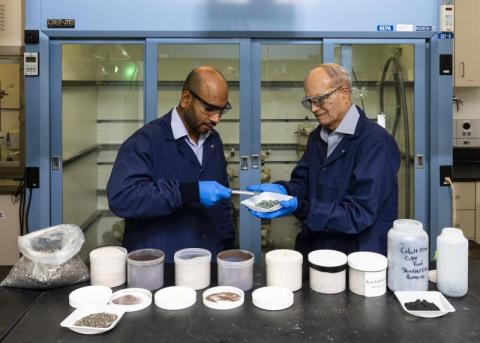
CMI researchers Syed Islam and Ramesh Bhave at Oak Ridge National Laboratory discuss the nickel sulfate recovered from end-of-life lithium-ion batteries using the membrane solvent extraction process they co-invented at ORNL. Their critical-materials recycling technique recently earned special recognition from the journal Advanced Engineering Materials, and the associated research project received a new phase of funding for research and development.
The journal selected a paper about the technology for its collection of the most outstanding articles published throughout the past year. The article, featured on the journal’s front cover, explains how the researchers applied the team’s membrane solvent extraction, or MSX, method to recover, separate and purify rare earth elements, or rare earths, from scrap permanent magnets taken from electronic waste.
Permanent magnets, which retain magnetic properties even in the absence of an inducing field or current, are used extensively in clean energy and defense applications. Rare earths are challenging to access because they are scattered across Earth’s crust, yet they are key components in many modern technologies. Recycled rare earths can be used to make new permanent magnets, accelerate chemical reactions and improve the properties of metals when included as alloy components.
“The editors chose the paper because it demonstrated the scalability and secure, long-term performance of the process,” said ORNL scientist Syed Islam, who co-invented the recycling approach and led the collaborative scale-up efforts. “Our industrial partner Momentum Technologies performed a technoeconomic analysis of all the inputs, extracting chemicals, membranes and lifetimes of the materials. Additionally, they validated that the process recovered more than 95% of the rare earth product at greater than 99.5% purity.”
See the full story: Revolutionizing resource renewal: Scaling up sustainable recycling for critical materials
